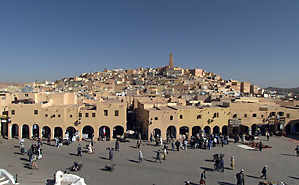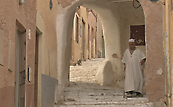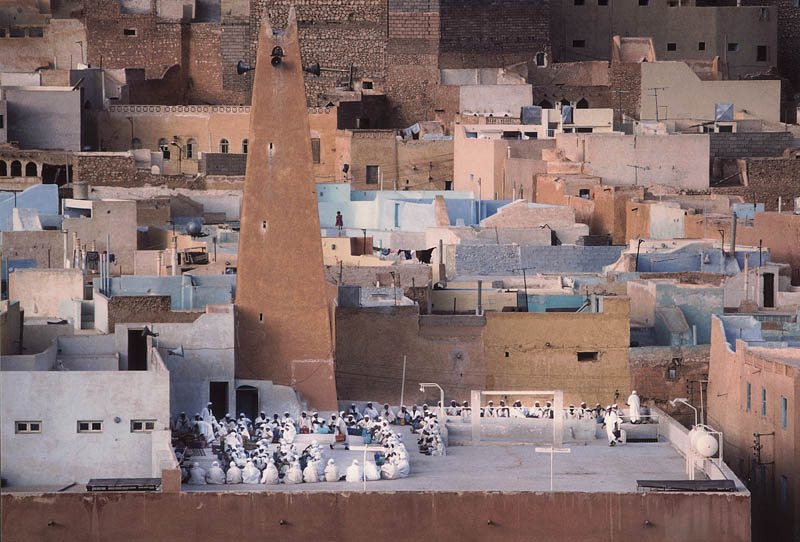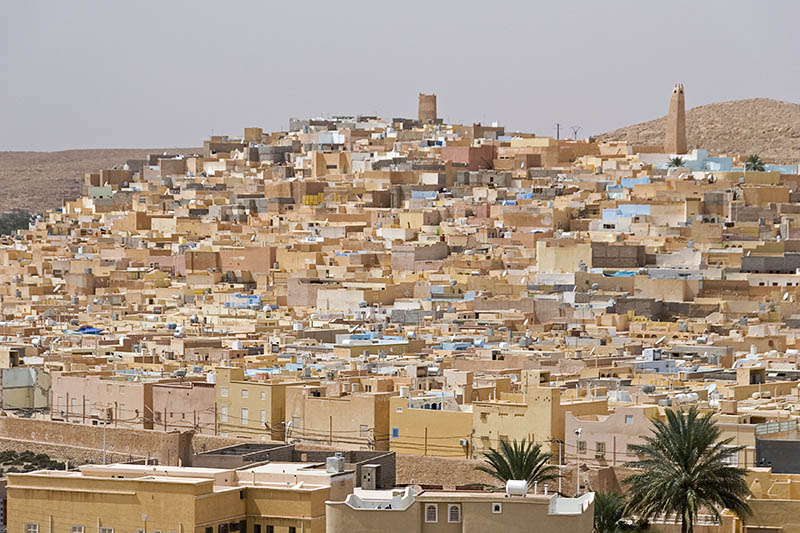 |
www.shejapan.com > World Heritages > M'Zab Valley
Quiz:
|
|
|
|
世界最大の砂漠サハラ。そこに、千年にわたり変わらぬ暮らしを守り続けてきた イスラムを信仰する人びとがいます。殺風景な岩の谷底に、鮮やかなパステル・カラーの四角い 家々が建ち並び、街はまるで、彩色されたピラミッドのようです。その美しさは、フランスの近代建築家 ル・コルビュジエが絶賛し、自らの建築技法であるキュビズム(立体主義)に取り入れたほどです。 そしてムザブの最大の特徴は、人びとが昔ながらのイスラムの教えを厳格に守り、厳しい規律の下で 生きていること。彼らは、自分たちの暮らしぶりが明らかになることを固く拒んできたために、 メディアにおいて今まであまり取り上げられることはありませんでした。ですからこの機会に是非 ムザブの谷について知っていただければと思います。<青山学院大学 経済学部 松井理恵>

Inscribed :1982 Criteria: (ii)(iii)(v)
Brief description:
A traditional human habitat, created in the 10th century by the Ibadites around their five ksour (fortified cities), has been preserved intact in the M’Zab valley. Simple, functional and perfectly adapted to the environment, the architecture of M’Zab was designed for community living, while respecting the structure of the family. It is a source of inspiration for today’s urban planners.
M'Zab Valley (World Heritage)
 The M’zab Valley is an oasis in the Sahara desert. Located
about 500 kilometers south of Algiers in the Ghardaia province
of Algeria, the 10-kilometer-long valley contains approximately
3,000 wells that supply 270,000 green date palms with water.
The M’zab Valley is an oasis in the Sahara desert. Located
about 500 kilometers south of Algiers in the Ghardaia province
of Algeria, the 10-kilometer-long valley contains approximately
3,000 wells that supply 270,000 green date palms with water.
The M’zab Valley has been inhabited since 1012, when M’zabite Berbers, a fiercely independent group of Ibadiyy Muslims, moved to the region in an attempt to escape robbers and persecutors. The M’zabites settled in the valley because it could be easily defended.
Over the next 36 years, they built five walled villages (ksars) on rocky outcrops along the valley: Beni Isguen, Melika, Bou Noura, El Ateuf, and Ghardaia, the principal city today.
The M’zabites were, and still are, a puritan sect. They dressed in simple garments, limited their use of color, and lived with little furniture. They designed their buildings for egalitarian communal living, with respect for family privacy.
The functional purism of the M’zabites’ faith led to a strict organization of land and space, with the arrangement of their communities following the terrain. The ksars, the fortified winter towns, were set on high ground. Summer dwellings were sheltered among the palm groves that filled the valley. Cemeteries were relegated to otherwise unusable desert areas.
All ksars included certain basic elements: the mosque (masjid), the Friday mosque (Azzaba masjid), school (madrasa), the open market (suq), neighborhoods and fortifications.
 A network of wide streets connected major community facilities in
the center of town, such as the Azzaba masjid and madrasa. Narrow
alleyways, designed for pedestrian traffic, branched from the streets
and ended in cul-de-sacs. The alleyways tended to follow the contours
of the land. They often were shaded by two-story houses, providing
protection from the Sahara sun.
A network of wide streets connected major community facilities in
the center of town, such as the Azzaba masjid and madrasa. Narrow
alleyways, designed for pedestrian traffic, branched from the streets
and ended in cul-de-sacs. The alleyways tended to follow the contours
of the land. They often were shaded by two-story houses, providing
protection from the Sahara sun.
The ksars were fortified by a series of thick walls, with towers and gates located at strategic points. These allowed the M’zabites to selectively close the town during times of exterior siege or internal strife.
As members of one of the major oasis groups of the Sahara desert, most M’zabites moved seasonally between the highland ksars and their corresponding communities in the cultivated valley. Production of dates in the summer towns was the basis for the economy of the winter ksars. The lowland towns were divided into neighborhoods, with surrounding walls and towers that defined ownership of the irrigated areas and ensured the privacy of homes.

The traditional M’zab house was built around a roofed courtyard with a small light well. The enclosed courtyard was used as a sort of family room and children’s play area, but it also was the focal point of special occasions, such as weddings. In addition, the ground floor would include the kitchen, a room for receiving female guests, and a space for storage and housing animals.
The second story, accessed by a covered staircase, had a more open courtyard. It was surrounded by rooms for receiving male guests, bedrooms, storage rooms and multipurpose spaces. From there, an open staircase led to the roof terrace, which would be partitioned into spaces for various family activities, such as sitting at night or sleeping.
This style of house allowed residents to enjoy life in the open air while living in a secure area protected on all sides.
In recent years, much new housing has been built outside the ksar walls. Although it employs contemporary construction methods and materials and incorporates modern conveniences, it often still adheres to the courtyard design.
Because the 11th century ksars have been well preserved due to the insular nature of the M’zabites, UNESCO designated the M’zab Valley a World Heritage Site in 1982, citing the ksars as intact examples of traditional human habitat perfectly adapted to the environment.
A federal council, comprising representatives of the five ksars plus three more recent towns (Guerara, Berriane and Ouargla), governs the valley. It follows Islamic law to rule all details of daily life, from clothing to the amount of gold given as a dowry (60 grams maximum). The council can impose punishments, including exile and a form of quarantine where the offender may not interact with his fellow citizens.

Even today, a visitor may not remain in a ksar after sunset unless accompanied by a resident, and non-Muslims are not allowed to stay overnight in Beni Isguen, the valley’s religious center. However, there are hotels and restaurants in Ghardaia, which serves as the regional base for tourism.
ムザブの谷の家々はどれも同じ様な造りとなっていて、 金持ちも貧乏人も同じ質素な家で暮らしています。 また、彼らは厳格なイスラムの教えに従い、人々は道徳を重んじ平等に暮らしています。 貧しい者は、豊かな者達がモスクに寄進したナツメヤシを手に入れる事も出来るのです。 このような厳格な平等の精神が民に宿っていなければ、 水を廻る争いが起き、千年もこの街は存続していなかったでしょう。
人々は、厳しい砂漠の中での生活環境を生き抜く為に、 イスラムの教えと祖先の教訓を真摯に受け入れ、 自然と上手く付き合う方法と、皆が力を合わせる大切さを受け継いでいるのです。
date palms
ナツメヤシ
Berbers
ベルベル人
egalitarian
平等主義
purism
純粋主義
terrain
地域
dwelling
住居
cemetery
墓地
siege
包囲
staircase
階段
adhere to
厳守する
The Cultured Traveler
NHK探検ロマン世界遺産
ムザブWikipedia
www.shejapan.com
> World
Heritages > M'Zab Valley
© 2007 SHEJapan.com